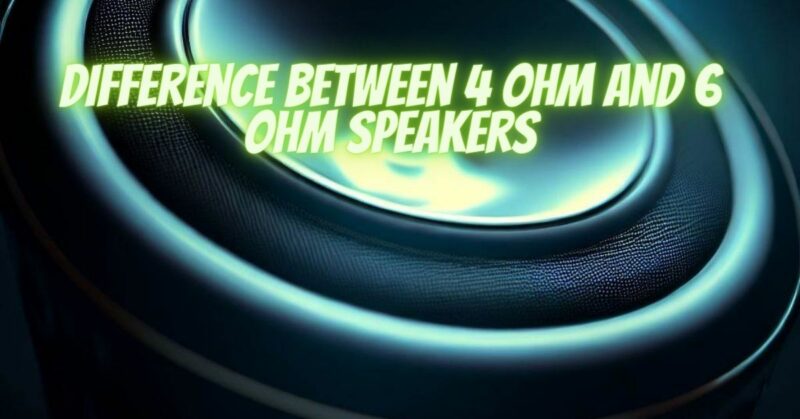When embarking on a journey to build the perfect audio setup, understanding the nuances of speaker impedance becomes essential. Impedance, measured in ohms (Ω), is a fundamental parameter that directly influences how speakers interact with amplifiers and ultimately shapes the sound they produce. In this article, we’ll delve into the differences between 4 ohm and 6 ohm speakers, exploring their characteristics, advantages, and considerations to help you make an informed decision for your audio system.
Understanding Speaker Impedance
Before delving into the specifics of 4 ohm and 6 ohm speakers, it’s crucial to grasp the concept of impedance in the context of audio. Speaker impedance represents the resistance that the speaker’s voice coil presents to the flow of electrical current from the amplifier. Impedance plays a pivotal role in determining the power distribution, efficiency, and sound quality of speakers.
Differentiating 4 Ohm and 6 Ohm Speakers
Let’s explore the distinctions between 4 ohm and 6 ohm speakers:
- Impedance Rating:
- 4 Ohm Speakers: These speakers have a lower impedance, which means they present less resistance to the flow of electrical current. As a result, they demand more current from the amplifier to produce the same amount of power.
- 6 Ohm Speakers: 6 ohm speakers have a slightly higher impedance compared to 4 ohm speakers. While they demand less current from the amplifier than 4 ohm speakers, they still require more current than higher impedance options.
- Power Handling and Amplifier Compatibility:
- 4 Ohm Speakers: Due to their lower impedance, 4 ohm speakers often require more robust amplifiers that can deliver higher current. They have the potential to handle more power and produce higher volume levels.
- 6 Ohm Speakers: 6 ohm speakers strike a balance between the demands of 4 ohm and higher impedance speakers. They can work well with a wider range of amplifiers and can handle moderate power levels effectively.
- Efficiency and Sound Output:
- 4 Ohm Speakers: These speakers generally have higher efficiency, meaning they can convert more of the amplifier’s power into sound output. They might produce louder sound levels compared to 6 ohm speakers.
- 6 Ohm Speakers: While they might be slightly less efficient than 4 ohm speakers, 6 ohm speakers can still deliver satisfactory sound output without placing excessive demands on the amplifier.
- Bass Response and Sound Characteristics:
- 4 Ohm Speakers: Lower impedance speakers like 4 ohm speakers can potentially yield a more robust and impactful bass response. They might be preferred for genres that require deep and powerful bass reproduction.
- 6 Ohm Speakers: 6 ohm speakers can offer a balanced bass response while maintaining a focus on overall tonal accuracy. They are versatile options that can cater to various musical genres.
Choosing Between 4 Ohm and 6 Ohm Speakers
Selecting the appropriate impedance for your speakers depends on your audio preferences, amplifier compatibility, and listening environment:
- Power and Bass Impact: If you crave powerful bass and impactful sound reproduction, 4 ohm speakers might be the preferred choice.
- Amplifier Considerations: If you already have an amplifier that’s optimized for 6 ohm loads, 6 ohm speakers ensure compatibility and effective power distribution.
- Overall Versatility: If you’re seeking a balanced sound profile with versatility across different musical genres, 6 ohm speakers offer a compelling option.
The choice between 4 ohm and 6 ohm speakers comes down to understanding their inherent characteristics and how they align with your audio preferences. Both options have their merits, and the optimal choice depends on your amplifier, listening goals, and the type of sound experience you seek. By comprehending the distinctions in impedance, power handling, and sound characteristics, you can make an informed decision that elevates your audio journey, ensuring that your speakers contribute to a rich, immersive, and satisfying sonic experience.

